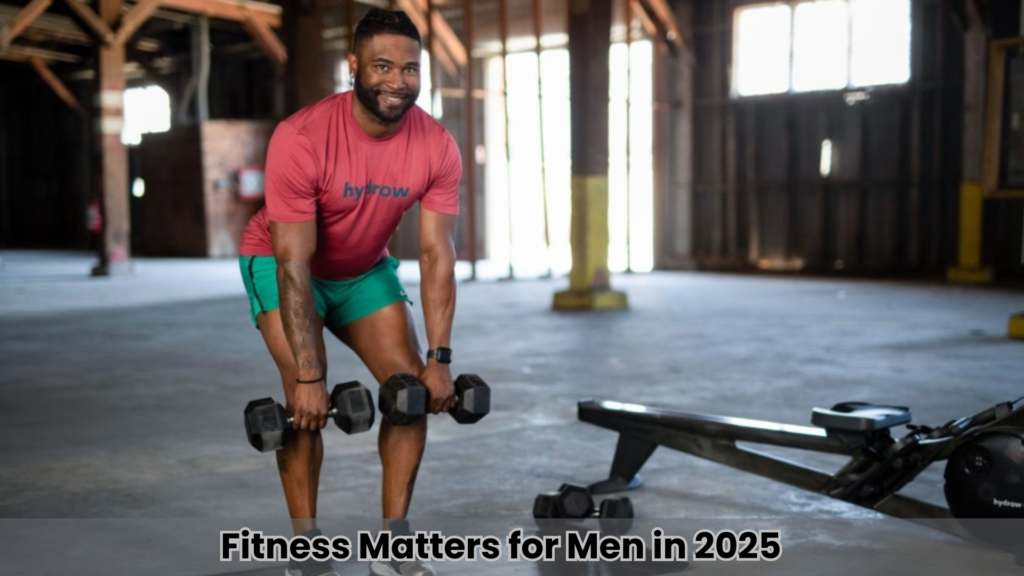Hello and welcome! What Are your reactions? If you’re reading this, you are gearing up to get fit in 2025 over the New Year holidays. You’ve found the right site if you’re starting or just coming into exercising. Men’s has changed over time, and 2025 presents excellent prospects for those willing to have healthy muscles, strength, and toned bodies. So what goes into it when we want to be fit? What are the most appropriate recommendations for novices in the present world of fast pace?
This guide contains the information, recommendations, and helpful hints you need to start on a journey to a healthier you. When you are done with this post, you will have a map to chart your course toward your fitness destination in 2025 and beyond!
Let’s dive in!
Table of Contents
Why Fitness Matters for Men in 2025

Fitness is not all about looks; it is also about health, longevity, and quality of life. Here are a few compelling reasons to prioritize fitness in 2025:
- Health Benefits: Based on this study it can be concluded that physical inactivity, the absence of systematic exercise to the levels that our genes require, is the beginning of chronic diseases including heart diseases, diabetes, and obesity prevalent in post-modern society.
- Mental Health: This often assists in elevating the brain to feel good hormones that reduce the effects of stress, anxiety or depression. This is so partly because it can help regulate emotions and improve self-image.
- Increased Energy and Vitality: The essentials of a good fitness regime boost energy, improve sleep patterns, and signify a healthy lifestyle.
- Longevity: Regular activities can add up to 7 years to your life!
Did you know?
According to a global research conducted by World Health Organization (WHO) on the effects of physical inactivity, death is due to either one of two causes: It’s fitness has never been as pronounced as it is today, and will probably become even more pronounced in the course of time.
This indicates worlds wherein fitness would never hold the same case as it does for everyone, countries, and even individuals.
Step 1 Setting Realistic Goals
Health is not the same as the practice of barbell pounding or jogging on the treadmill. Soon, you will have a balanced exercise regimen that will improve your strength, flexibility, stamina, and heart health. Here’s ‘so, incorporate different elements into your fitness plan:
Strength Training
Strength Training is recommended 3-4 non-consecutive days per week. Continue hypertrophy training only with the freedom to hit this intensity weekly.
Strength training is one way of pumping our muscles, increasing bone mass, and even ramping up the metabolism. Strength training is crucial because men break points or lose muscle mass as they age. Here’s get started:
- Focus on Compound Movements: Unlike the previous exercises these exert pressure on several parts of the body at once and as such give more strength within the same amount of time. Barbell exercises are the most effective ones amongst which are squats, deadlifts, bench presses, pull ups etc.
- Use Progressive Overload: This should be done systematically to ensure that there isn’t a situation where someone will be forced to move backward in their routines.
- Start with Bodyweight Exercises: To beginners, do not use weights in the first weeks and keep to bodyweight movement including push-ups, squats, and planks.
Cardio (2-3 Days a Week)
Aerobic exercises are exceptional for heart fitness and are appropriate procedures for losing fat. Cardio should not be missed, whichever form it takes: running, cycling, swimming, or HIIT (High-Intensity Interval Training).
- Mix It Up: If you follow the cardio exercises for several weeks, you will start to get bored, and your workout will be less effective. For instance, change steady-state cardio (running) with HIIT to achieve better fat loss.
- Start Slow: For those just starting cardio training, begin with low-impact exercises like walking on the treadmill, cycling, or elliptical training. When endurance increases, more specific types of cardio—running and HIIT, for example—can be performed.
Flexible Case Scheduling Tips
Yoga or stretching activities are important in minimizing the risk of injury while enhancing function and movement patterns. Incorporating other mobility exercises into your physical activity would enable you to move with ease and increase flexibility.
- Yoga for Men: Surprisingly, most men ignore yoga, but it’s it’s way to increase flexibility, work off stress, and build muscles after weight training.
- Stretching: Static stretching should be done after exercise, and dynamic stretching should be done before exercising since this improves flexibility and decreases Muscle tightness.
Rest and Recovery
This refers to the concept that rest is as essential to muscle development and injury prevention as exercise. Strive for at least 1-2 days of rest per week and try to sleep enough at night, 7-9 hours a day.
- Pro Tip: Include days off during the training process and only moderately load the body daily (it is allowed to do gentle walks or yoga classes).
Step 3: Nutrition for Fitness
Because nutrition is attached to each workout plan, no efficient fitness plan can exist without it. A good nutritional plan for bodybuilding involves taking the right foods and nutrients that help with exercising, building muscles and body tissue, and recovering.
The following video explain about: Flexible Case Scheduling Tips
Macronutrients for Men
Macronutrients are large amounts of nutrients necessary for the body; they include protein, carbohydrates, and fats.
- Healthy Fats: It’s wrong to try and avoid fats since they’re an essential component of your body’s hormones and joints. Erin and Jonny of Utah Nutrition and Wellness report some of the foods that should be categorized as good foods include; avocados, nuts, seeds and olive oil.
- Protein Protein aims should be around the middle of range 1.2 to 2 milligrams per kilo of body weight. Muscle recommendations are true because, as you must recall, protein is a nutrient necessary in building and replenishing muscle tissue. The food with little fat that contains protein include lean meat, fish products, eggs, and legumes as well as protein supplements.
- Carbohydrates: Carbohydrates are the energy that enables one to undergo difficult workouts. Also, adopt ‘slow-release’ carbohydrate foods such as whole grain products, oats, sweets as they make energy for many hours.
Step 4: Consistency and Motivation Template

Fitness is not done once in a while or a day, but it is for life. The biggest struggle that many men encounter whenever they are beginning the fitness journey is the issue of maintaining consistency. Here are some tips to help you stay on track:
Track Your Progress
You can lose track of your workouts, meals, and progression, so you can benefit from apps or journals. Recording your experiences helps you confront the greatness you are experiencing or hold yourself accountable for your laziness. It also assists you in determining what’s five and making the appropriate changes.
Find a Workout Partner or Community
It can help to have a training partner or join one of many online fitness forums. It is important to have people around you who will encourage you as you work towards a healthier you.
Set Mini Goals
Besides the long-term fitness goals, have short-term sub-goals that inspire you daily. For instance, “I’d like a 5-pound increase on bench press this month,” or “I’ll complete the 5k run in under 30 minutes.” These are mini goals, and they assist in creating momentum and also in creating the conditions to self-congratulate.
Conclusion
Fitness to men is not only about the outside appearance, not about fitting into the slim suits and tuxedos, but about the quality of life. If you stick to these tips and try them daily, it won’t win; in 2025, you will get fitter than you are today. Whether one wants to lose some weight, gain muscles, or have better heart health, every step one takes is nearer to better health.
So, are you ready to take that first step towards your dream fitness body today?
FAQs
1. How frequently should a beginner be in the gym exercising?
For beginners, the prescribed frequency is 3-4 days a week. It is a great way to add strength and muscle endurance to your body without overloading it.
2. The only remaining step is to find out when is the best time of day for exercise.
Unfortunately, there are no universal recommendations that can be made here. The best time to exercise is that which the individual finds convenient when they are alert and best suited for discipline.
3. Is it possible to get a ripped abdomen from an exercise without lifting lots of weights?
Yes, you can! If bodyweight exercise and light weights are formulated correctly and practiced frequently, a lot can be achieved. They should concentrate on the manner in which they are done and continually raise the degree of the loads that are being handled.
4. What strategies help to follow an exercise regimen?
Look for a workout partner, have more minor achievements to work on daily, and have fitness celebrations. To achieve and maintain motivation and successful results, it is vital to remain constant.
5. On your own, is it necessary to take supplements if you’re not burnable?
Supplements may be helpful but not essential, provided individuals take the necessary vitamins and minerals from their diets. Increase your consumption of protein sources and only turn to supplements if a protein source cannot be found.



